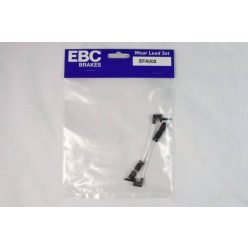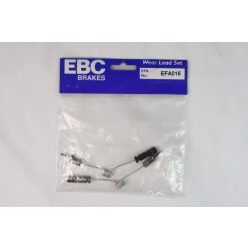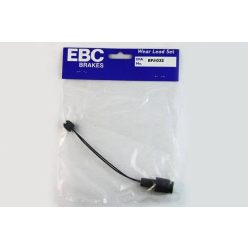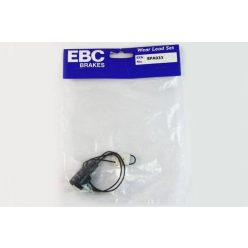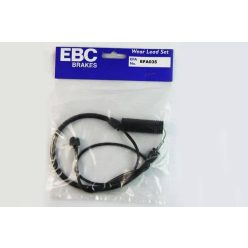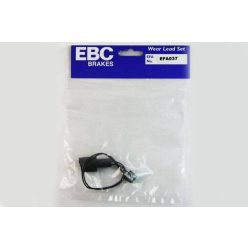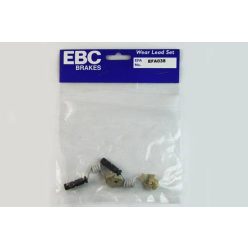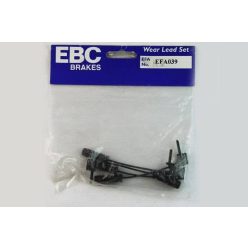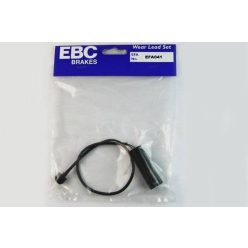Our Brake Pad Wear Sensors category offers OE-style wear sensor leads primarily for EBC brake pad applications on front and rear axles. These electronic brake pad sensors monitor pad thickness and trigger a dashboard warning light when the pads reach a critical wear limit, helping you avoid metal-to-metal contact and costly rotor damage. Heat-resistant insulation and model-specific connectors ensure reliable operation even under high brake temperatures and harsh road conditions.
Net price: 6 €
Net price: 18 €
Net price: 46 €
Net price: 15 €
Net price: 10 €
Net price: 11 €
Net price: 14 €
Net price: 11 €
Net price: 11 €
Net price: 10 €
Net price: 19 €
Net price: 27 €
Role and Benefits of Brake Pad Wear Sensors
Brake pad wear sensors continuously monitor your brake pad thickness and signal when pads are approaching their safe minimum. In most modern systems an electronic wear indicator is clipped into or moulded onto the pad and, once the material wears down, it changes the electrical state of the circuit. This prompts the control unit to switch on a warning light in the instrument cluster so you can schedule a pad change before friction material is exhausted. By replacing pads and sensors in time you reduce the risk of metal-to-metal contact, overheating and sudden loss of braking performance.
On many newer vehicles, especially in the premium segment, the indicator logic is more advanced. Two-stage or multi-stage sensor designs allow the ECU not only to warn that pads are worn, but also to estimate remaining mileage and display it during service. This turns the wear sensor into a predictive maintenance tool that helps keep braking performance consistent while avoiding unnecessary early pad replacements.
Technical Basics
The classic electronic brake pad wear sensor consists of a high-temperature insulated wire and a small sensor head that snaps into a slot or pocket in the pad. In simple one-stage designs the wire forms a loop embedded in the friction material; as the pad wears and the loop meets the rotor, the circuit opens or changes resistance, which the ECU recognises as a wear event. More sophisticated sensors stack two resistor circuits at different heights so the control unit can distinguish between “service due soon” and “pads worn out” states and log remaining life.
Because sensors sit next to the caliper and disc, they must withstand extreme temperature cycles and harsh contamination. Harness sections are typically rated for around 150–200 °C, while the sensor head and sleeve may be specified for up to 250–350 °C in short bursts, depending on design. Housings and insulation are formulated to resist brake dust, road salt and cleaning chemicals. A key distinction is between old-style mechanical “squealer tabs” which rely on noise, and true electronic wear indicators which silently trigger a dash light; many vehicles use a mix of both across axles.
Typically only 2–4 wheels are equipped with electronic indicators—the most heavily loaded positions on the car. Some systems place sensors on the inboard pads, which tend to wear faster, to ensure the indicator reflects the worst-case pad. On heavy-duty or commercial vehicles, position sensors located in the caliper rather than the pad may be used to track pad movement across its full life span.
Selection Criteria
When choosing new brake pad wear sensors, the most important step is matching the part to your vehicle’s make, model, year and brake system specification (OE, EBC or other aftermarket kits). Connector shape, cable length and clip style are all vehicle-specific, so a sensor must be designed for your exact application to ensure secure fitment and reliable signalling. Product data will typically specify whether the sensor fits the front or rear axle and which side, as well as any pad or caliper references.
It is also worth checking whether your car uses single-stage or multi-stage wear sensors. Multi-stage designs are often required where the dash shows remaining pad life or differentiates between a service reminder and a critical warning; fitting a simpler sensor can disable these functions or store incorrect service data. When selecting pads, confirm whether a separate clip-in sensor lead is needed or the indicator is integrated into the pad—some platforms are sold as complete pad-and-sensor sets for convenience.
From a cost–benefit perspective, wear sensors are relatively inexpensive compared with pads, rotors and calipers. Many manufacturers recommend replacing the sensor leads every time pads are changed, as heat and vibration can fatigue the wire, insulation and clips over time. Attempting to reuse old sensors or bypassing the circuit (for example by joining wires) eliminates a key safety feature and can also confuse service interval calculations in modern systems.
Installation & Maintenance
Brake pad wear sensors are usually replaced during a pad change. The old sensor head is carefully unclipped from the pad and the harness is released from all routing clips and brackets, avoiding damage to adjacent wiring. The new sensor must be fully seated in the pad slot or holder so that its active element sits at the correct depth, and the cable should follow the original path with all retaining clips refitted to keep it away from moving components and hot exhaust or suspension parts.
Check that the cable does not become taut at full steering lock or full suspension travel, and that it cannot chafe on sharp edges. The connector should be clean and dry, with intact seals to keep out moisture; if the original plug is corroded or cracked, it is wise to repair or replace it at the same time. After fitting new pads and sensors, some vehicles require a brake service or pad life counter reset with diagnostic equipment—if this step is skipped the warning light may remain on even though the hardware is new.
In service, brake pad wear sensors need little attention, but periodic visual checks are sensible, especially on high-mileage or track-driven cars. Look for burnt, brittle or cracked insulation and any sign of rubbing or crushed sections. Intermittent warning lights, or a light that stays on after obvious issues are fixed, may indicate internal breaks in the sensor harness. Given the relatively low cost of replacement, it is usually more effective to fit a new sensor than to chase borderline wiring faults in a harsh environment like the wheel well.
FAQ
What does a brake pad wear sensor actually do?
A brake pad wear sensor monitors pad thickness and alerts the driver, usually via a dashboard light, when the pads reach a predetermined wear limit. This removes the need for frequent manual inspections and helps prevent pads being run down to the backing plate, which can damage rotors and reduce braking performance.
Do all cars have electronic brake pad wear sensors?
No. Many modern vehicles use electronic wear indicators, but older or simpler models may rely only on mechanical squealer tabs—or nothing at all. If your car has no factory system, retrofitting is usually not cost-effective; instead, regular visual pad checks are essential for safe operation.
Should I always replace the sensor when changing brake pads?
Best practice is to fit a new wear sensor lead every time you replace pads on a sensor-equipped axle. The old sensor has been exposed to the same heat and vibration as the pad, and reusing it increases the risk of intermittent warnings or complete failure of the indicator system later on.
Why is my brake wear warning light still on after pad and sensor replacement?
This may be caused by an incorrectly seated or faulty new sensor, a damaged harness or connector, or a brake service interval that has not been reset in the ECU. Start by checking connections and routing, then use appropriate diagnostic equipment to clear stored fault codes and reset the pad life counter if required.
Is it safe to bypass a brake pad wear sensor by joining the wires?
Electrically it may extinguish the warning light, but it is not recommended. Bypassing the circuit disables an important safety feature and increases the risk of running pads beyond their safe limit, which can lead to brake fade or component failure. Modern two-stage systems also cannot be safely “cheated” this way, making proper sensor replacement the only sensible option.

